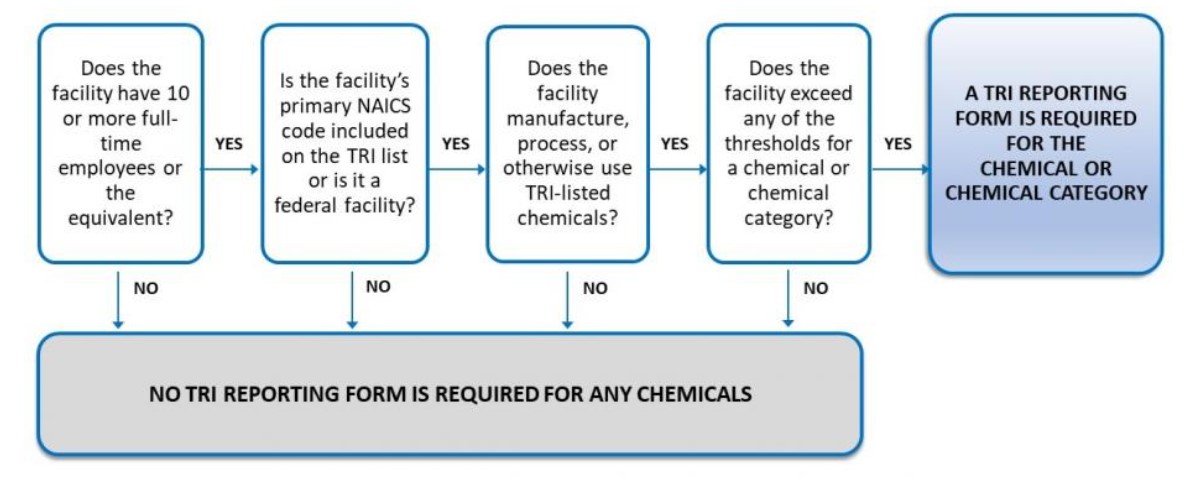The Toxic Release Inventory (TRI) reporting deadline is just around the corner – July 1, 2021 – and many facilities are just now starting to think about what they need to report. In addition to the newly listed 172 per- and poly-fluoroalkyl substances (PFAS) materials that need to be reported, TRI reporting can be tricky when you look behind the curtain. Below we cover some of the finer points of TRI reporting.
What is Form R Reporting?
The United States Environmental Protection Agency (USEPA) TRI is a resource that provides data associated with production, environmental releases, and waste management practices of listed toxic chemicals (40 CFR §372.25-29) from certain facilities. TRI employs Form R or Form A Reporting for each listed chemical to comprehensively evaluate annual use, recycling, reclamation and other waste management activities, environmental releases, and pollution prevention activities of TRI listed chemicals. This annual data is then used to produce the TRI National Analysis, the official annual TRI Report.
Any facility that employs more than ten people and meets the requirements for TRI reporting is required under the Emergency Planning and Community Right to Know Act (EPCRA), Section 313 to submit an annual Form R or Form A Report by July 1st to the USEPA and relevant TRI State Agency – which is also where facilities can report their progress on waste reduction activities in their annual Report. A simple decision tree by the USEPA can help facilities determine if they need to complete TRI reporting:

The Basics – TRI Chemical Reporting Thresholds
Generally, the threshold for reporting TRI chemicals that are manufactured or processed throughout the calendar year is 25,000 pounds while the threshold for toxic chemicals that are “otherwise used” throughout the calendar year is 10,000 pounds. Manufacturing includes the production or import of a TRI-listed chemical while processing includes the use of a TRI-listed chemical as a reactant, a formulation component, or offered for recycling or reclamation. Common ‘otherwise uses’ of a TRI-listed chemical include as a manufacturing aid (e.g., refrigerants, hydraulic fluids) or an ancillary use such as for wastewater treatment. Consider this example for manufacturing/processing versus otherwise used:
- The use of certain solvents as a thinner or a cleaner in painting operations – when the solvent is used as a thinner, it is being processed as part of the manufacturing process, whereas when it’s used as a cleaner, it is “otherwise used” as an ancillary step to manufacturing.
The Tricky Part
Determining whether your facility meets the threshold for a TRI listed chemical isn’t always straightforward. New toxic chemicals or chemical categories as well as new covered industry sectors can be added to the TRI annually. Some chemicals are considered to be more toxic and have lower reporting thresholds. Reporting exemptions also exist and include exemptions for certain TRI covered sectors, for TRI chemicals present in minor concentrations, and for some activities considered an “otherwise use” such as motor vehicle maintenance. Below are some common areas facilities can get tripped up in reporting:
- The USEPA has identified chemicals of special concern (CSC) including persistent bio-accumulative toxics (PBTs) that have lower chemical-specific thresholds and ineligibility for some reporting exemptions. PBTs are considered to be highly toxic and long-lasting substances with the ability to build up within the food chain and potentially harm human and overall ecosystem health. The TRI program has designated sixteen toxic chemicals and five chemical categories as PBTs. PBTs are typically pesticides, polynuclear aromatic hydrocarbons (PAHs), polychlorinated biphenyls (PCBs), lead and mercury, and are often found in burning, smelting and refining operations.
These materials have significantly lower reporting thresholds – 100 pounds or less. It’s important to review safety data sheets (SDSs) for these materials to determine if any of their components are a TRI listed chemical and whether sufficient quantities of the material were processed, manufactured, or otherwise used throughout the calendar year to trigger reporting. An oft-missed substance is lead in lead solder – manufacturing, processing or otherwise using more than 100 pounds in a calendar year triggers TRI reporting. - The USEPA employs several exemptions including the de minimis exemption which “allows covered facilities to disregard certain minimal concentrations of non-PBT chemicals in mixture or trade name products.” This exemption does not apply to the manufacture of a non-PBT chemical unless it is manufactured as an impurity and remains in the distributed product, or it is imported below the corresponding de minimis It also does not apply if a non-PBT chemical is manufactured coincidentally as a result of manufacturing, process, otherwise use, or waste management activities.
To determine whether the exemption applies to a specific non-PBT chemical, the concentration of the chemical in mixtures and trade name products must be assessed and if found to be below the appropriate de minimis level, all releases and other waste management activities associated with the chemical are exempt from EPCRA Section 313 reporting. As can be seen in the USEPA’s common questions and answers regarding specific incidents, there are many circumstances in which a facility might believe they qualify for the de minimis exemption, when in fact they do not. For example, if a mixture contains several xylene isomers that individually are below the de minimis threshold but exceed the reporting threshold as an aggregate, the facility should report the mixture as xylenes (mixed isomers). - The newest chemicals on the rise, PFAS were included in Section 7321 of the National Defense Authorization Act (NDAA) for Fiscal Year 2020 and added to the list of TRI chemicals. PFAS includes a variety of man-made chemicals often found in food packaging, commercial household products such as stain repellent fabrics, polishes, waxes, and cleaning products, production facility material such as chrome plating or electronics manufacturing, drinking water associated with a specific manufacturer, or wastewater treatment, as well as living organisms that contain PFAS from build-up over time.
The USEPA now requires TRI reporting for PFAS, effective for the 2020 reporting year and due by July 1, 2021. The added chemicals include perfluorooctyl iodide (507-63-1), potassium perfluorooctanoate (2395-00-8), and silver(I) perfluoro-octanoate (335-93-3). All TRI reporting requirements will apply to these PFAS chemicals including the de minimis level for Perfluorooctanoic acid (PFOA) (CASRN: 335-67-1), set at 0.1%. All other PFAS chemical additions have a de minimis level of 1% and the NDAA has established a reporting threshold of 100 pounds for each of the added chemicals.
Given these particularly low thresholds, facilities will need to review individual SDSs for per- and poly-fluoro isomers and determine if any such materials exceed the de minimis concentrations and reporting thresholds. This may represent a challenge as they can be contained in “proprietary mixtures.” Because more guidance from the USEPA on such mixtures has not yet been published, if PFAS are suspected in these mixtures, facilities should consider contacting manufacturers to determine if PFAS are contained in these mixtures.
Putting It All Together
While TRI reporting may initially seem daunting, facilities that have good insight into how much of each TRI listed chemical is used in facility production, waste management activities, energy recovery and recycling, pollution prevention activities, and environmental releases can more easily navigate the trickier parts of TRI reporting. Thoroughly understanding and documenting a facility’s overall process flow, chemical usage, and production and waste activities will facilitate a more thorough and efficient reporting process whereby the potential pitfalls above can be avoided.
Sources
Toxics Release Inventory (TRI) Program
Addition of Certain PFAS to the TRI by the National Defense Authorization Act




